Laura Kalpakian's Blog, page 6
April 23, 2019
This One’s for the Writers!
You’ve written “The End.” Bravo. Celebrate! Buy champagne, dance in the streets! But inevitably after that glorious moment, you drag yourself to your desk, open a new folder called Version 2, or Revision, or New Draft. Whatever. You’re thinking: oh shit, here we go again.
This is the point where you want to put your characters in a pickup truck. The image of the pickup truck is a revising tool that gives authors the opportunity to ask important questions, to streamline their thinking before embarking on the next draft. You know a lot more now than when you started out. Trust me.
This pickup truck is old, a old Dodge, maybe with a running board and a column shift, or maybe four-on-the-floor. Gears that grind. Windows that creak when they roll down. No air conditioning. No blue-tooth. AM radio bristling with static. A bench seat, probably torn, upholstery tufting out. Some characters sit in the cab. Some are bouncing in the back of the truck. Maybe one or two ride on the running board. Each has a relationship to the others, though perhaps not to all the others. The destination is irrelevant.
To revise your book using the pickup truck, begin with the driver. Who is the driver? Sometimes the answer is obvious, Huck Finn is the driver; Jim is in the passenger seat. Everyone else in that novel is in the back of the truck even if they don’t want to be. (The Duke and Dauphin insist on the running board). If the driver in your book isn’t immediately apparent to you, ask yourself: who changes? Your work can (and should) develop many characters, but only one person can drive the truck, the person whose changes propel the story.
In a first person narration—fiction or memoir–the driver is the Narrator. In creative nonfiction, the driver is probably the individual with whom the narrative begins. In beginning with that person, the author endows him/her with importance. In the finest creative nonfiction (John McPhee, for instance) even if his true subject is the land, McPhee develops people with significant relations to that land; the story returns to these people again and again, and we see the land through their experiences. In fiction told third person, you should be able to identify the central character by asking who’s story is it? Put that person behind the wheel.
Once you have your driver, then ask: Who is in the cab with the driver? These are the relationships that will fuel your story, that will inform your characters’ choices, and highlight their challenges. With the bench seat on an old Dodge you can cram as many as four people into the cab, but not more than that.
 In The Great Gatsby Nick Carraway is at the wheel. Jay Gatsby is in the passenger seat and Daisy Buchanan sits between them. Daisy links them; she is Nick’s cousin, and Jay’s undying love for her sets the events in motion. Jordan Baker, Tom Buchanan, Myrtle and George Wilson, they are in the back of the pickup. Everyone else in that novel is in the U-Haul. (Yes, your pickup can be pulling a U-Haul.)
In The Great Gatsby Nick Carraway is at the wheel. Jay Gatsby is in the passenger seat and Daisy Buchanan sits between them. Daisy links them; she is Nick’s cousin, and Jay’s undying love for her sets the events in motion. Jordan Baker, Tom Buchanan, Myrtle and George Wilson, they are in the back of the pickup. Everyone else in that novel is in the U-Haul. (Yes, your pickup can be pulling a U-Haul.)
In One Flew Over the Cuckoo’s Nest even though the Chief is the narrator, clearly, the guy behind the wheel is McMurphy. The Chief is in the cab along with their nemesis, Nurse Rachet. In To Kill A Mockingbird, Scout is behind the wheel even if she’s too young to drive. Atticus and Jem and Boo Radley are in the cab with her. Atticus and Jem because the novel is finally a story of family. And Boo? Boo is the beneficent ghost who hovers over the whole book linking all the threads. Everyone else in To Kill A Mockingbird remains in the back of the truck. There is no U-Haul. Frank McCourt is at the wheel of Angela’s Ashes with mum and dad. Everyone else in that noisy, crowded memoir is in the truck bed, probably pounding on the back window, cursing or crossing themselves.
In my novel, The Great Pretenders, the first person narrator, Roxanne Granville is at the wheel. In the cab with her are her grandfather, Leon, and her lover, Terrence. Her unresolved anger toward her grandfather (complicated by her love for him) will inform many of her choices. Her love for Terrence—forbidden by everything and everyone around her—will challenge and reward her. And yet Leon and Terrence have no relationship to one another. They do not know each other. Their paths do not cross. However, once I started thinking about the back of the pickup, I noticed a character who, in the early drafts, was so minor he merely carried sandwiches on a tray. I could see that the he alone linked the two major story-lines; obliquely he linked Terrence and Leon. Thus, when I returned to the script to revise, I heightened his portrayal. He is now present, described in the first scene. He informs the last scene. He’s still in the back of the pickup, of course, but he is given more narrative weight, more ink throughout the novel.
Your characters may bring assorted objects with them to the truck. These items detail, identify their values, and choosing them helps guide your revisions. In The Great Pretenders Jonathan and Denise both cling to vanity and ambition. Charlie clings to his surfboard. Irene clings to her fine house, her fine clothes, her sapphire ring—and what it symbolizes. Irene would put her children in the U-Haul, and that’s where I put them too.
As you populate the cab, the back of the truck and the U-Haul, you are looking for relationships that need to be enhanced and enlivened in revision. And those that need to be diminished. Roxanne’s mother was originally in the back of the truck, but in the early drafts I moved her to the U-Haul. She was needy and annoying; she absorbed narrative space I could have spent developing characters who had significant roles to play. Her role was in the past, off-screen, so to speak, the damage she’d done to Roxanne as a kid. By the fourth draft, I had put the mother by the side of the road and sent her to the Bahamas, never to appear in these pages again. She left with her inebriate husband who had not one line of dialogue, which was another good reason to get rid of them.
 So yes, the truck can stop and characters ordered out. But you can also stop for hitch-hikers. In The Great Pretenders Thelma Bigelow was a hitch-hiker. Originally she just had a job, secretary to a blacklisted writer. Midway through the writing the truck stopped for her and she climbed in the back. And a fine addition she was too. She provides wisdom, caution which Roxanne sadly lacks.
So yes, the truck can stop and characters ordered out. But you can also stop for hitch-hikers. In The Great Pretenders Thelma Bigelow was a hitch-hiker. Originally she just had a job, secretary to a blacklisted writer. Midway through the writing the truck stopped for her and she climbed in the back. And a fine addition she was too. She provides wisdom, caution which Roxanne sadly lacks.
The pickup truck has been useful to me over the years as a revision tool. I first stumbled on it many years ago when I put all sorts of characters in the back of a pickup and it took me three weeks to find out who they were and what they were to one another. They were a lively, irreverent bunch, but as I have revised this book over years, at least half of them have been ordered out of the truck bed, out of the U-Haul and left by the side of the road.
Just remember it’s a pickup truck, not a bus. Big difference.
The post This One’s for the Writers! appeared first on Laura Kalpakian.
April 16, 2019
Cyrano de Bergerac and The Great Pretenders
Cyrano de Bergerac—brilliant wit, exquisite poet, undefeated cavalier—is unredeemably ugly. His nose, a giant, disfiguring schnoz, renders him unfit to play the lover to any woman, much less the lovely Roxanne. She is in love with the handsome soldier, Christian. To help his tongue-tied rival win Roxanne’s love, Cyrano speaks his own words, immortal protestations of love. beneath her balcony. She believes Christian is speaking to her from his heart, and replies rapturously. The young couple elopes. Then it all goes to hell.
When Christian dies in battle, the shattered Roxanne declares she will never love another, and betakes herself to a nunnery. Shut away from the world, her gaiety and beauty and youth wither behind convent walls. Cyrano becomes a weekly visitor to the convent, a witty but avuncular figure. Years pass thus, until one day, Cyrano is bested by sneaking assailants, and mortally wounded. He nonetheless drags himself to his weekly appointment with Roxanne. The older, wiser Roxanne confesses to Cyrano that though she loved Christian’s beautiful face and form, truly it was his heart, she loved, the depth he expressed in words; she would love him even if he were ugly. At last Cyrano can tell her the truth of his love for her. The man dying in her arms is the man Roxanne had loved all along. She has lost him twice. A true tragedy.
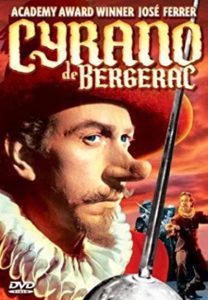 Set in 17th century France, the era of The Three Musketeers, Edmond Rostand’s 1896 play is full of swath and grandeur. It has been staged so often it’s rather an old theatrical warhorse now, over-done gestures, gleaming swords, brandishing capes, all so dated. But the dialogue! Cyrano’s witty aphorisms, his take-downs of the vain, the crass, the bullying, his words of love, those remain wonderful! Even in the earliest drafts of The Great Pretenders, I could see parallels to the story I wanted to tell. After all, at its heart, Cyrano de Bergerac is a great literary hoax, perhaps the greatest literary hoax ever. Roxanne Granville too perpetrates a literary hoax. As Cyrano uses his silvery words to woo Roxanne, so Roxanne Granville asks young, unsuccessful writers to offer their names to cover for her disgraced friends.
Set in 17th century France, the era of The Three Musketeers, Edmond Rostand’s 1896 play is full of swath and grandeur. It has been staged so often it’s rather an old theatrical warhorse now, over-done gestures, gleaming swords, brandishing capes, all so dated. But the dialogue! Cyrano’s witty aphorisms, his take-downs of the vain, the crass, the bullying, his words of love, those remain wonderful! Even in the earliest drafts of The Great Pretenders, I could see parallels to the story I wanted to tell. After all, at its heart, Cyrano de Bergerac is a great literary hoax, perhaps the greatest literary hoax ever. Roxanne Granville too perpetrates a literary hoax. As Cyrano uses his silvery words to woo Roxanne, so Roxanne Granville asks young, unsuccessful writers to offer their names to cover for her disgraced friends.
In early drafts of the novel Roxanne named her agency Cyrano. I changed it to the simple Granville Agency because as the story unfolded, the parallels grow somber. The play is a tragedy of everyone using everyone else. Cyrano uses the young beautiful soldier as a front for his love; the inarticulate soldier uses Cyrano to voice what he cannot say, and when Christian dies, the old poet is stuck in the mire of his successful lies: Roxanne can never love another. I didn’t want that for my characters.
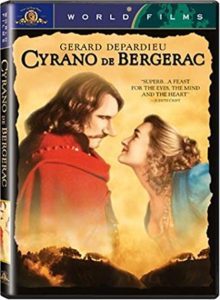 Nonetheless, the play echoes through novel, a sort of “tuning fork” that pings continually, especially with the notion of panache! Cyrano, though he did not invent panache, certainly embodies it. His wit, skill, charisma, irreverence, all create a sparkling aura around him. He declares “Nothing can take my panache!” and he is correct; it’s a gift.
Nonetheless, the play echoes through novel, a sort of “tuning fork” that pings continually, especially with the notion of panache! Cyrano, though he did not invent panache, certainly embodies it. His wit, skill, charisma, irreverence, all create a sparkling aura around him. He declares “Nothing can take my panache!” and he is correct; it’s a gift.
In my novel Roxanne Granville often speaks of panache, but she has to earn hers. She does not always sparkle, though she models her actions on the daring Cyrano, fond of dramatic gestures, and sassy bravado. She makes mis-steps and errors. She sometimes hears the whisper of her grandmother’s voice reminding her Never forget that you are Roxanne Granville, named for the romantic heroine of a great play. Only toward the end of the novel does she recognize that, like the original Roxanne, she has matured through suffering she has largely brought on herself.
The post Cyrano de Bergerac and The Great Pretenders appeared first on Laura Kalpakian.
April 5, 2019
Panache
Panache appears often in The Great Pretenders, not simply as an effervescent gift given to a fortunate few people, but as a cologne the characters actually wear. In fact, an early working title for the novel was “A Touch of Panache.” This fictitious cologne has a history.
In 1931 Empire Pictures made the first talkie of Cyrano de Bergerac, the 1896 play in which Cyrano’s panache plays an important role. The head of Empire Pictures, Leon Greene, asked a parfumier to concoct Panache, a signature, commemorative scent for his wife, Julia. She alone could wear Panache, until the day she gave a bottle to her teenage granddaughter, Roxanne. (Roxanne could wear the fragrance, but found it far more difficult to live up to Julia’s maxim that “Glamour is nothing more than knowing how to talk fast, laugh fluidly, gesture economically and leave behind a shimmering wake.”) As I was creating Panache for the page, I imagined my three favorite scents. “…the top notes are citrusy, the lower notes an earthy bergamot with a hint of vanilla.”
“Glamour is nothing more than knowing how to talk fast, laugh fluidly, gesture economically and leave behind a shimmering wake.”
Then, one of the novel’s early readers suggested that Panache could also be an intriguing cocktail. What a good idea!
[image error]Eight of us gathered on a winter’s night. We had candlelight, enticing apperitivos, an array of glasses and a fabulous display of gleaming liquor and liqueur bottles (some exotic, some well known) that seemed to glow with possibility. Our mixologist, Bacchus Taylor, was both expert and adventurous. (How could he not be with such a name?) We, the testers, were prepared to test and talk all evening till we found the perfect Panache. In truth, Bacchus, who had been thinking on this for days, took the three signature scents, swirled them with champagne and Campari, and voila! The Panache! Though an icy winter wind whipped round the house, the Panache made us all feel summery,
Sipping, each of the flavors presents itself in turn, beginning with the whiff of fresh lemon, finishing with the whisper of bergamot. The slightly bitter Campari is softened by the champagne, Visually, the Panache is lovely to look at. The Campari creates a rosy glow at the bottom of the flute, and the whole floats in sparkling champagne, reminiscent to me of the “shimmering wake” that Julia Greene thought essential to being glamorous.
We took the Panache idea to Alli Sutherland, general manager of Galloway’s Cocktail Bar in Old Fairhaven, and she reproduced it beautifully. So next week, on April 16th from 4 to 6, that’s where The Great Pretenders will launch, and celebrate publication day.
You can celebrate too even if you can’t be at Galloway’s. Collect your friends, or your book club, create your own Panache Cocktail, revel in a bit of old Hollywood glamour. For added ambience, here are playlists redolent with jazzy glamour and cool panache.
The Panache
1 Tablespoon vanilla simple syrup
1 Tablespoon Campari
1 Flute Champagne
1 Drop bergamot essential oil
1 Twist of lemon
To prepare Vanilla Simple Syrup
Add one cup water, one cup sugar, and ½ vanilla bean scraped with the husk and bring to a boil. Stir and let cool. Keeps for one month in refrigerator.
To prepare the Panache Cocktail
Pour the Vanilla Simple Syrup into the flute. Fill to one inch of the top with Champagne. Slowly pour the Campari into a spoon held right above the Champagne and gently tilt into the drink. Add the essential oil of bergamot and twist of lemon. Enjoy!
[image error]For the perfect twist of lemon
Cut your lemon in half. Cut a slice from the half. With your fingers, pull off the fruit from the peel. Taking the long loop of peel, twist it over the glass (so the oils drip into the glass). Roll it a couple of times in your fingers, and slide it into the glass. It will rest there like a fragrant plume.
Bergamot essential oil is available in specialty stores or online.
Panache Playlist
Spotify
iTunes
The post Panache appeared first on Laura Kalpakian.
March 29, 2019
Dedications
I always read the dedications of books. I always wonder about what that person meant to the author. Some are transparent. “To my father…..” “To my son….” Others less so. My favorite dedication of all time is from 1931, “The Archie and Mehitabel Poems” by Don Marquis. (Archie is a cockroach who sneaks into the newsroom at night and uses the typewriter to write free verse.) Marquis dedicated his book “To Babs. For Babs knows what. And Babs knows why.” You can never top that one.
My many books have been dedicated to a few close friends, and to supportive agents, but mostly to my sons, my sister and my mother. THE GREAT PRETENDERS has a unique dedication.
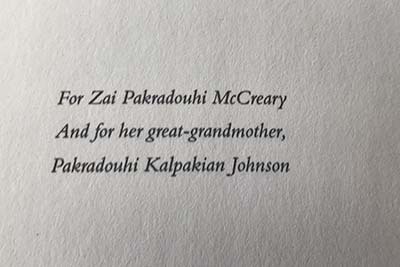
Pakradouhi (pronounced Pahk-rahd-o-oui) is the Armenian name given to my mother when she was born in Constantinople in March 1922 . It is the feminine of Pakrad, an Armenian prince c. 1100. Her parents were originally from southeastern Turkey, forced to flee to Syria where they had lived for four months before coming to Constantinople. Pakradouhi was born shortly after they arrived. Constantinople was but a stop off; the family had plans to emigrate to the US, to Los Angeles where my grandmother had relatives, a brother and sister who had emigrated about fifteen years earlier.
Extensive planning took over a year before the Kalpakians could embark: my grandparents, Haroutune and Haigouhi, Pakradouhi, about fifteen months, her older sister Angagh, age five, and my grandmother’s brother, Haig, age seventeen. The story of that journey is too long and too heartbreaking to be told in this short space. Suffice it to say they ended up crossing the Mediterranean and the Atlantic twice. They finally landed in Rhode Island in October 1923, and from there went to New York. From New York they rode the train. No doubt looking weird and weary, they were met in Los Angeles by the Boyds. (This family had already changed their name from Boyajian to Boyd.) In her Centennial Memoir, my mother describes this meeting:
“They may have thought we looked ‘right off the boat.’ Mama, age 22, was 6 months pregnant, her long, heavy skirt hung lopsided due to the pregnancy. Her two small daughters, Angagh and I, clung to her skirt. Did we smell of moth balls? Maybe. Mama could speak some English, the rest of us could not. [Mama said] that the Boyds gave a party for us when we arrived. I, as a toddler, of course have no memory of this party, but I sincerely hope they gave us a little time to recover from that grueling trip before we were trotted out to meet total strangers.”

The Boyds, thoroughly Americanized, could say Angagh’s name, but not Pakradouhi. Too much of a mouthful. At first her cousins called Pakradouhi “Peach Face,” but eventually that evolved into Peggy, a chirpy popular name for girls in the 1920’s.
And Peggy she stayed. She started kindergarten and graduated from high school as Peggy Kalpakian. When at age 21 she got her own naturalization papers, she was told if she wanted to change her name, now was the time to do it. She did it, became Peggy Kalpakian. A year later she married Bill Johnson and became Peggy Johnson. Later, her grandsons gifted her with the name, Maudie. Pakradouhi vanished into the distant, unremembered past.
In 2017 when my son Brendan and his wife Shweta knew they were expecting a girl, they told my mother they were giving their daughter Pakradouhi, as a middle name in her honor. My mother wept with disbelief, with joy, to have her original name reunited with the family for the first time in 95 years.
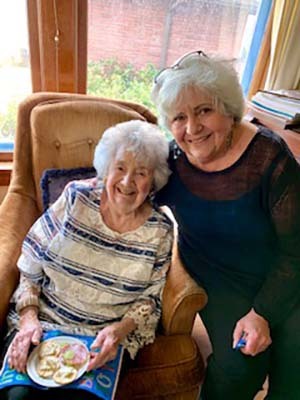
No doubt Zai Pakradouhi McCreary (born January 2018) will roll her eyes, perhaps even resent it when she will be obliged to pronounce the name, and answer the incessant question, “How did you come by such a weird name?” She will tell the story of how it was taken from her great-grandmother, not by nefarious means, but the simple, slow, relentless erosion of Americanization. And every time Zai tells the story, she will, of necessity remember her great-grandmother. My mother’s original name will be restored, not simply to her, but to posterity. This makes my mother happy. Makes all of us happy. One day it will make Zai happy.
So with this dedication to THE GREAT PRETENDERS I thought to connect the oldest and the youngest of my family. My mother turned 97 this week. And Zai Pakradouhi McCreary, the toddler, is just about the same age her great-grandmother was when her family braved the Atlantic and the Mediterranean–twice–to find a new life in America.
The post Dedications appeared first on Laura Kalpakian.
March 20, 2019
Hollywood Memoirs
Juicy, sometimes salacious, full of glamorous details or outrageous incidents, the memoir–with its whispered invitation, “This is true!”–far more than the novel, is the literary genre ideally suited to Hollywood.
Many people affected by the blacklist wrote memoirs. The ones I read were interesting, but not especially compelling, like actor Lee Grant’s I Said Yes To Everything (a great title). The book covered her whole life, which is to say, long swaths of time that weren’t especially dramatic. My three favorite memoirs read in researching The Great Pretenders, were not chronological narrative. They were more episodic, free form essays, or in the case of Jean Stein, oral histories from her famous childhood friends leavened with her own tart wit and recollections.
[image error]Her book, West of Eden: an American Place (2016) has the voices of glamorous and sometimes tragic people telling their tales which gives the book a sense of intimacy. Stein adds her own thoughts and a gloss on celebrity. She was never just an observer. Jean Stein (born 1934) is the same generation as my central character, Roxanne Granville who was born in 1931. Like Roxanne she grew up a Hollywood daughter amid all that opulence and famous names. Verve and élan describe Jean’s entire life; she was a writer, editor, theatrical producer, philanthropist, and all-round Utterly Astonishing Person. Sadly, though, she committed suicide at the age of 80 in 2017. West of Eden was her last book.
Budd Schulberg’s Moving Pictures (1980) recounts his parents’ and grandparents’ histories. His father started out in the entertainment business in the earliest days of one and two-reelers in New York. In a unique career full of ups and downs, Budd’s father eventually became the president of Paramount Pictures. Budd (born 1914) tells of his close boyhood friendship with Maurice Rapf whose father was president of MGM. The chapters are arranged in chronological fashion, but they’re more like essays detailing Budd’s dawning social conscience, his friendship with the famous and mercurial superstar, Clara Bow, youthful scrapes, and one whole chapter on raising pigeons. (I skimmed this one.) The book ends with a sad knell when his parents long, productive marriage has broken up, and young Budd is about to leave Hollywood, to attend Deerfield Academy in Massachusetts.
Budd Schulberg went on to a long, adventurous, contentious, lively and lauded career. He too was scarred by the blacklist but not because he was exiled and forced out of work. On the contrary, Schulberg was one of those who happily chirped to HUAC when asked to name names of his former Commie comrades. Like Elia Kazan (who also named names and with whom he created On the Waterfront) Schulberg made lifelong enemies with his testimony. Though he continued to work intermittently in Hollywood, he lived on the East Coast. He wrote books about boxing, but never another memoir. He died in 2009.
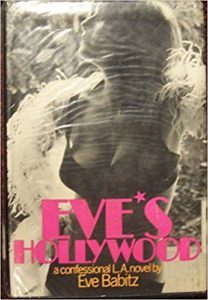 My third favorite memoir, Eve’s Hollywood, was first published in 1972, and recently reissued. The book was (as they say) Unputdownable. Eve Babitz was born in 1943, into bohemian Hollywood, an artistic milieu quite removed from the corporate life of Paramount or MGM. Her book is a series of piquant essays. The style throughout is brisk, impatient, and flamboyantly uncaring of the reader’s neat little assumptions. Eve tells her story in a way that makes plain she doesn’t give a shit about looking wholesome. Her narrative voice is seductive and shocking and utterly enticing. The acknowledgments page alone is worth the price of the book.
My third favorite memoir, Eve’s Hollywood, was first published in 1972, and recently reissued. The book was (as they say) Unputdownable. Eve Babitz was born in 1943, into bohemian Hollywood, an artistic milieu quite removed from the corporate life of Paramount or MGM. Her book is a series of piquant essays. The style throughout is brisk, impatient, and flamboyantly uncaring of the reader’s neat little assumptions. Eve tells her story in a way that makes plain she doesn’t give a shit about looking wholesome. Her narrative voice is seductive and shocking and utterly enticing. The acknowledgments page alone is worth the price of the book.
The post Hollywood Memoirs appeared first on Laura Kalpakian.
March 8, 2019
Three Hollywood Novels
Hollywood novels offer different fictional perspectives on that cocktail of hope and despair, sex and ambition that has always flourished amid the land of high stakes make-believe. The Great Pretenders follows in these classic footsteps.
Of all the Hollywood novels I’ve read, however my three favorites (all wildly different from one another) were published in about 1941. The Last Tycoon is poetic, romantic, elegiac; it was unfinished at F. Scott Fitzgerald’s death. Nathanael West’s Day of the Locust is a sort of nightmare vision, surreal, beset with bizarre characters. Day of the Locust is still an unsettling read, eighty years after its publication. Budd Schulberg’s What Makes Sammy Run is quick-paced, and lively, and so contemporary in its tone that I had to keep reminding myself it was published in 1941.
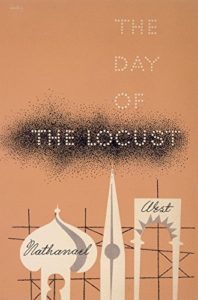 I first read Day of the Locust as a displaced Californian, a grad student on the east coast one miserable winter afternoon. I lived in a basement apartment where light barely eked in through high windows. I was entranced by West’s descriptive prose, especially when I stumbled on his perfect evocation of a Southern California twilight, the lavender dusk…. I closed my eyes and on the strength of his writing, went home to the lavender dusks and the yellow hibiscus blooming in winter. Usually when I find writers I like, I binge-read through everything they wrote. Alas, for West there isn’t much. Nathanael West and his wife died in a car crash the day after F. Scott Fitzgerald died in December 1940.
I first read Day of the Locust as a displaced Californian, a grad student on the east coast one miserable winter afternoon. I lived in a basement apartment where light barely eked in through high windows. I was entranced by West’s descriptive prose, especially when I stumbled on his perfect evocation of a Southern California twilight, the lavender dusk…. I closed my eyes and on the strength of his writing, went home to the lavender dusks and the yellow hibiscus blooming in winter. Usually when I find writers I like, I binge-read through everything they wrote. Alas, for West there isn’t much. Nathanael West and his wife died in a car crash the day after F. Scott Fitzgerald died in December 1940.
Fitzgerald’s friend, the critic Edmund Wilson edited what the author had actually written of The Last Tycoon, and offered observations based on the notes FSF left behind at his death. The Last Tycoon was published it in 1941. Wilson and other critics believe that if FSF had lived to finish it, the book would have been his best. I disagree. The writing is beautiful and evocative, but the pov is fractured among several characters whose lives occasionally intersect, as though FSF could not quite decide whose story it was.
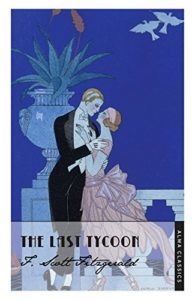 The novel begins with young Cecilia Brady, a first person narrator. In that opening chapter she is returning to Los Angeles after an expensive east coast education. She is a daughter of Hollywood royalty, but ambivalent about her powerful family. However, portraying women was never FSF’s great strength. The novel also explores the conflicts swirling around unionization of Hollywood actors, writers, and studio workers. Fitzgerald worked in the movie business for the last few years of his life, and he would have been vividly aware of union strife all around him. But that proletarian torch was not his to pick up. FSF was an arch romantic trying to make a living in an era when writers of gritty literature (Steinbeck, Erskine Caldwell, James M. Cain) shone and prospered. FSF was best portraying young men like Dick Diver, Jay Gatsby, and Monroe Stahr, their impossible dreams, their sad, but foreordained trajectories.
The novel begins with young Cecilia Brady, a first person narrator. In that opening chapter she is returning to Los Angeles after an expensive east coast education. She is a daughter of Hollywood royalty, but ambivalent about her powerful family. However, portraying women was never FSF’s great strength. The novel also explores the conflicts swirling around unionization of Hollywood actors, writers, and studio workers. Fitzgerald worked in the movie business for the last few years of his life, and he would have been vividly aware of union strife all around him. But that proletarian torch was not his to pick up. FSF was an arch romantic trying to make a living in an era when writers of gritty literature (Steinbeck, Erskine Caldwell, James M. Cain) shone and prospered. FSF was best portraying young men like Dick Diver, Jay Gatsby, and Monroe Stahr, their impossible dreams, their sad, but foreordained trajectories.
(That said, the recent Amazon series of The Last Tycoon made much of these union themes, created new characters, and deepened FSF’s characters, weaving them together with the historical milieu of the Depression. I thought it was very well done; too bad the series only got one season.)
Unlike FSF—who was something of an outsider all his life—Budd Schulberg knew Hollywood intimately; his father was the head of Paramount Pictures. And yet his central character in What Makes Sammy Run (1941) is an outsider, a scrappy Jewish kid. Starting out as a copy boy at a New York newspaper Sammy Glick, makes his way to the top of the Hollywood heap. He does so by shamelessly pillaging, backstabbing, betraying everyone he encounters. What Makes Sammy Run is narrated by a sort of Nick Carraway in reverse, Al Manheim, who is fascinated by the kid’s undisguised zeal and ambition. Manheim is Sammy’s first mentor, and also his first victim. The turbulent rise of the unions in Hollywood figures largely in the novel, as does the unhappy fate of those talented people who cast their dreams into the Hollywood maw.
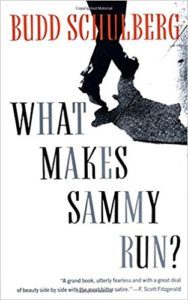 The book, though wildly successful, cost Schulberg dearly among his friends and peers. Many hated it because in creating the vile Sammy, Schulberg seemed to perpetrate the anti-Semitism that Jews in Hollywood had so long struggled to fight. That Schulberg himself was Jewish, an insider, a scion of Hollywood royalty made it all the worse.
The book, though wildly successful, cost Schulberg dearly among his friends and peers. Many hated it because in creating the vile Sammy, Schulberg seemed to perpetrate the anti-Semitism that Jews in Hollywood had so long struggled to fight. That Schulberg himself was Jewish, an insider, a scion of Hollywood royalty made it all the worse.
These three novels are more-or-less contemporary with the events they describe, the late 1930’s. The Great Pretenders, by contrast, is historical, set in the 1950’s, an era I had to research extensively. In some ways, though, my book tips its hat to FSF’s Cecilia Brady. Like Cecilia, Roxanne Granville is a Hollywood brat returning home after a fancy education, uncertain of her future, and ambivalent about her powerful family. Unlike Cecilia, Roxanne is able to thrash through the thicket of challenges that beset her, to discover courage she didn’t know she had.
The post Three Hollywood Novels appeared first on Laura Kalpakian.
February 16, 2019
THE GREAT PRETENDERS sweepstakes
https://sweeps.penguinrandomhouse.com...
February 15, 2019
Refusing to let history slide into the past.
The Montgomery Bus Boycott on Film
The 2001 film, BOYCOTT is essential viewing for Black History Month. It portrays the year long Montgomery Bus Boycott, winning many awards, including a coveted Peabody Award for “refusing to allow history to slip into the past.” It is available again on HBO and as a DVD.
I found BOYCOTT to be moving, stirring, and unique, combining scripted drama and documentary techniques. True, they have Martin Luther King Jr’s actual speeches, and no doubt minutes of meetings, and it’s partially taken from a book, Stewart Burns’ “Daybreak of Freedom.” But also there are many documentary-style moments when people turn to the camera, breaking down the “Fourth Wall” and address the audience, telling us what they think/feel under these circumstances. Some of these people are actors, clearly, but some of them are elderly men and women, and I suspect they were participants in the actual 1955 boycott. Some reviewers found this didactic. I found it compelling. I was also impressed with how skillfully the filmmakers wove in details that illuminated the story and the people who figured in these events. Some names are known to all, Martin Luther King Jr., Rosa Parks, some not. The casting was brilliant.
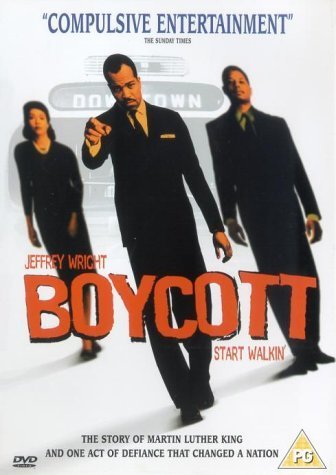 Jeffrey Wright (“Westworld,” “Boardwalk Empire”) portrays Martin Luther King Jr with restrained gravity. King was elected the leader of the Montgomery Improvement Association, the group that led the boycott, not because he was an icon, but because he was new to Montgomery, pastor of the Dexter Avenue Baptist Church. He was the choice because local leaders were contentious. These were not a band of saints all singing the same tune in the choir. These men and women struggled over tactics, and voices, and who-had-the-right-to-speak-for-whom.
Jeffrey Wright (“Westworld,” “Boardwalk Empire”) portrays Martin Luther King Jr with restrained gravity. King was elected the leader of the Montgomery Improvement Association, the group that led the boycott, not because he was an icon, but because he was new to Montgomery, pastor of the Dexter Avenue Baptist Church. He was the choice because local leaders were contentious. These were not a band of saints all singing the same tune in the choir. These men and women struggled over tactics, and voices, and who-had-the-right-to-speak-for-whom.
The late Reg E. Cathey (“The Wire,” “House of Cards”) plays E. D. Nixon, a now forgotten activist who was the leader of Montgomery NAACP. We see Mr. Nixon being thwarted, aggravated, but unswerving in his commitment. Ralph Abernathy, King’s stalwart ally, is played by Terrence Howard (“Empire,” “Dead Presidents” a little known but terrific film). Eric Dellums (“The Wire”) gives a moving performance as the brilliant, troubled lawyer, Bayard Rustin. Carmen Ejogo (“True Detective”) plays Coretta Scott King tenderly, as a wife and mother conflicted for her family’s safety amid the press of these compelling events. She would later play Mrs. King again in another drama of another crucial moment in Civil Rights History, 2014’s “Selma.” (Wikipedia offers up the morselette that Carmen Ejogo and Jeffrey Wright met on the set of “Boycott,” married and later divorced.)
Iris Little-Thomas gives Rosa Parks’ quiet fortitude an intimate portrayal. The director, Clark Johnson (“The Wire”) used a montage of arresting images flashing by Mrs. Parks’ vision as she sat on the bus just before she was ordered to relinquish her seat to a white man. She later told someone she was thinking of Emmett Till just before that moment. Emmett Till, just a boy, had been brutally murdered in Mississippi in August 1955 in a crime that shocked the nation.
For me the biggest casting surprise was the appearance of none other than the incomparable Aaron Neville as an extra! What? How could Aaron Neville be an extra? His face and presence are unforgettable. He stood, deep in the crowd surrounding MLK’s house the night it was bombed. (January 30th 1955).
Aaron Neville contributed to the 3 CD soundtrack album, apparently only available as a CD, not streamed. But below you’ll find two great albums of civil rights songs that might well have been sung, voices that might have been heard in the Dexter Avenue Church, as black Montgomery citizens walked to and from work for 381 days rather than sit in the back of the bus.
Playlists
Spotify
iTunes
The post Refusing to let history slide into the past. appeared first on Laura Kalpakian.
February 7, 2019
“A darkened theatre was our favorite place on earth.”
“I don’t go to the movies for the film. I go for the religious experience.”
“I don’t go to the movies for the film. I go for the religious experience,” Roxanne Granville tells readers of The Great Pretenders. For Roxanne’s grandfather, head of Empire Pictures, movies were about power and money, but for her grandmother, Julia, “They were her passion and she shared that passion with me. A darkened theatre was our favorite place on earth. She used to take me to matinees when I didn’t weigh enough to hold down the seat. Sometimes we’d go to the glamorous palaces like Grauman’s Chinese, but often we’d take in a double feature at a little music box of a theatre in Westwood. The false opulence, plush carpets, stale air, and palliative darkness combine to create a sacred space. A place of solace, hushed and holy. I recognized this same consecrated ambience the first time I walked into Notre-Dame in Paris.”
I share Roxanne’s sentiment. I brought my kids up with a passion for pictures. I took them to the movies before they weighed enough to hold the seat down. While they were growing up, there were three theatres in this town. In each you immediately entered an enclosed space from which all natural light was banished. Other than that, they had significant differences.
“I brought my kids up with a passion for pictures. I took them to the movies before they weighed enough to hold the seat down.”
Sunset Square had four small, stuffy auditoriums where your feet stuck to the spilled pop and popcorn on floor, and the seats were sprung. On summer afternoons mothers would often bring their kids, shoo them to the front, then sit in the back and chat the whole time. The Sehome theatre was where the artsy pictures showed, the Jane Austen remakes. The seats were sprung, but the air was not as bad. The mall complex theatres, six of them, were where you went for the Great Big Pictures. Still stuffy, but at least they didn’t smell, and sprung seats were replaced. However, thunderous artillery from the war film in the next theatre would rattle your fillings in your teeth while on your screen a tender love scene unfolded. Crash! Bang! Boom!

The Pickford

Now, all three of these theatres are closed. The mall complex is gone entirely, turned into a chain restaurant. The other two are hulking spaces, shuttered, grim, forlorn. Now, built in what was once a meadow is a new Super Duper Regal complex (sixteen or so auditoriums complete with 3-D and other mega-wonders). Entering this vast enclosed lobby, you instantly squint against the onslaught of neon and flashing lights. At the concession stands, people mill in long lines like they’re awaiting a TSA search. Soft drinks come in the size of horse troughs, popcorn in the equivalent of oaken barrels. The plush seats are so steeply tiered I get vertigo near the top.
The other local experience for film is the Pickford, the city’s arthouse cinema, now celebrating its twentieth anniversary. Supported by memberships and an all volunteer staff (except for the projectionist) it is indeed a “little music box of a theatre.” The Pickford is my favorite place in town.


I don’t know who designed this space, but they clearly had a recognition , even a reverence for the sense of community that a theatre can create. The lobby has windows! Tables and chairs invite conversation. Comfortable chairs, a small sofa also suggest connection. The Hollywood Reporter and the Chuckanut Reader (the local independent bookstore’s quarterly mag) lie on the end tables beside thriving houseplants. The lighting is warm, no florescent, no neon, the carpet simply patterned. The lobby is such a welcoming public space that my book club meets there each month. We buy a reasonably priced wine and a couple of popcorns (in ecologically friendly bags) pull some tables together and talk about books. In short, the Pickford has created a space where both cinema and community can flourish. Where the arts are nurtured, and people who love the arts feel welcomed.
In that respect, the Pickford reminds me of Cinema Paradiso from the famous movie of the same name, a place that nurtured audiences–and talent. At the Pickford a young projectionist, Ryan Covington, a friend of my sons, dreamed of making his own films while images filled the screen. On the strength of a prestigious screenwriting competition where his work was a finalist, Ryan Covington moved to Los Angeles a few years ago. His film, THE SECRETS WE KEEP, is in pre-production with a director assigned, producers and the central characters cast. I look so forward to seeing it at the Pickford! The place where it was first created as an idea.
Laura Kalpakian, author of THE GREAT PRETENDERS, a novel of Hollywood in the Blacklist Era will introduce and discuss the film, TRUMBO at the Pickford Film Center on May 2 2019.
*Photo credits: Jake Holt
Playlists
And, for your listening pleasure, here is a bespoke playlist, guaranteed to evoke the romance of a darkened theatre.
Spotify
iTunes
The post “A darkened theatre was our favorite place on earth.” appeared first on Laura Kalpakian.
January 29, 2019
Pierino’s Restaurant, La Cienega Boulevard, Los Angeles, California, 1927–1981
Like Roxanne Granville you too can enjoy Pierino’s in its heyday.
Pierino’s, the restaurant frequented by Roxanne Granville in The Great Pretenders, is well known to me. I invented it when characters from my novel American Cookery had lunch there in 1956. When I returned to Pierino’s for The Great Pretenders I added the flagstone drive and valet parking.

Joe Pierino, his brother Paul and their friend, Ernesto Marchiani all emigrated to Los Angeles from Poggibonsi, Italy in 1915, just before they would have been conscripted to fight in a capitalist war. By 1919 Ernesto Marchiani had become Ernest March, the broodingly handsome silent film star who was making $250 a week. Paul Pierino was a well regarded set decorator. Joe borrowed money from them and opened his restaurant in 1927. Prohibition required a back room which cost Joe plenty to maintain—to have alcohol there at all, and to be certain he wouldn’t be raided. He managed. His wife and sons did the cooking. The place prospered.
After Prohibition ended Joe struggled through the Depression. To his wife’s ire he traded a mural painted by a hungry Socialist artist for a free meal once a week. (This artist later became known as the Los Angeles Chagall.) During World War II any soldier in uniform got dessert and a liqueur on the house, a practice that cost Joe plenty.
But after the War, his old loyalties cost him more. In the post-war years if you had old country Socialist ties, or had once evinced a youthful enthusiasm for left wing politics, or had shouted anti-capitalist slogans with your comrades at strikes or marches (all of which Joe and Paul and Ernest had done), even if you betrayed a sneaking sympathy for any of the above, your life could be ruined.
Old Man Pierino’s old country ties, his loud loyalty to his old Socialist friends doomed him and doomed his brother. In 1950 Paul Pierino was called before the House Un-American Activities Committee where an actor, naming names, pointed the Red Finger at Paul, and insinuated sexual misdeeds as well. Publically accused of being a pinko-deviant, blacklisted, and at risk of being arrested for contempt of Congress, Paul fled, returned to Italy, to Rome. Later he worked on the films of Sergio Leone.
When the Committee was through disgracing Paul Pierino, people were afraid to be seen at Joe’s restaurant. Joe Pierino, for all his resilience and ingenuity, had no way to fight rumor, innuendo, fear of association with a Commie. His health faltered, his spirit sank.
But his son Frankie who had been cooking in the restaurant since he was ten, was smooth, shrewd, close-mouthed, all-American. Frankie closed the place down, got a loan, tore it apart, even the famous mural, and reopened in 1952 with mid-century chic decor: blonde wood paneling, blonde wood tables embraced by great rounded banquettes of red vinyl. The floors were a tough blue tile that could stand up to stiletto heels, where the crowded foyer rang with low, sophisticated voices, men in suits, women in hats and gloves, their cigarette smoke sinuous, and a jazz piano man playing standards. For twenty years Pierino’s was the sophisticated place to eat in Los Angeles, a landmark. Then, for ten years it was a cliché. The site is now a parking lot.
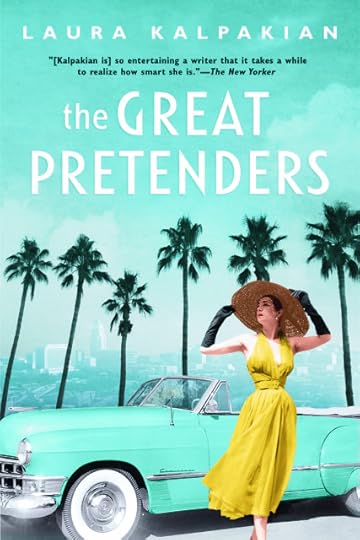
Like Roxanne Granville you too can enjoy Pierino’s in its heyday. Here is the recipe for their signature dish, Rigatoni with Seafood and Pepper Sauce, redolent with the smell of the sea, yellow lemons and red peppers. Joe’s wife wrote it down on a card.
Rigatoni with Seafood and Pepper Sauce
These proportions for one pound pasta
2 or 3 red bell peppers, perhaps four peeled garlic cloves, handful fresh basil, parsley, oregano, thyme, rosemary. Chop all. Should have some texture. Certainly not pureed. Heat olive oil in a cast iron fry pan and cook the above quickly on a high heat. Add (big can) of crushed tomatoes and some red wine, reduce heat and simmer. (Or half a dozen chopped fresh tomatoes. If this, use extra salt.) Sprinkle with a teaspoon of crushed dried red peppers if desired, salt, pepper. Simmer a bit, maybe twenty minutes, adding more vino if necessary. Cover.
Take 1 pound mixed seafood. You can find this at the fishmarket, usually frozen; mostly the rag ends of this and that, bits of scallop, octopus, squid, shrimp, clams, mussels, whatever seafood you have you can use. Thaw and rinse. You can add more of whatever you like, for color and texture, steamed mussels, clams, but this is a good basis, and not expensive.
In a broad fry pan put the juice of two lemons and perhaps half a cup of dry vermouth, one tablespoon. of olive oil. Bring to a boil, reduce heat and let cook down by perhaps a third. To this, add your seafood and toss, cooking only as long as necessary. The pieces in the seafood combination are always small bits, so not long. Remove from heat. Add to Pepper Sauce and mix well. Add to cooked rigatoni. Use your just-steamed mussels and clams, a bit of chopped Italian parsley for color.
Serve immediately. Excellent. A winter version without basil could use pizza seasoning or Italian seasoning, dry.
And, of course, don’t forget the music while you cook!
A customized playlist to accompany your meal.
Spotify
iTunes
The post Pierino’s Restaurant, La Cienega Boulevard, Los Angeles, California, 1927–1981 appeared first on Laura Kalpakian.



